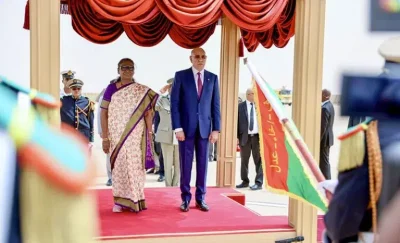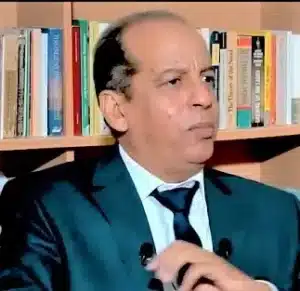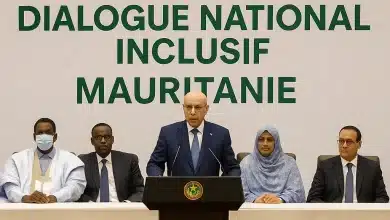To celebrate her Excellency, the President of India’s visit to Mauritania


Ould Sneiba, Ely. « Gandhi, Ruskinian Hero. » International Journal of Science and Research (IJSR) 12, no. 4 (April 5, 2023):
International Journal of Science and Research (IJSR)
ISSN: 2319-7064 SJIF (2022): 7.942
Volume 12 Issue 4, April 2023
www.ijsr.net
Licensed Under Creative Commons Attribution CC BY Gandhi, Ruskinian Hero
Ely Ould Sneiba
Lecturer, University of Nouakchott, Mauritania
Abstract: Mahatma Gandhi was an example of John Ruskin’s political influence. Ruskin inspired him to develop a political philosophy that became a universal philosophical and moral current. The Great Soul devoted all his intellectual and physical resources to the cause of freedom, social well-being and full development of Indians. He made it possible for India to achieve independence by peaceful means and with the non-violent participation of the Indian nation. He was also the instigator of the culture of tolerance and respect for others for Indian national cohesion.
Keywords: Ruskin, Gandhi, non-violence, tolerance, democracy, national cohesion, independence of India, political philosophy, spirituality and sacrifice
Around the world, John Ruskin inspired politicians and reformers. Gandhi was one of them. The Great Soul declared that he had aligned his existence with the ideas expressed in
Ruskin‟s seminal book Unto This Last. Similarly, Gandhi‟s socio-political philosophy and nonviolent struggle for emancipation became a path for freedom fighters to follow.
In Africa, for example, Gandhi‟s philosophy catalysed widespread awareness and pan-African emancipation, and he has been imitated and emulated, politically and
spiritually.
Gandhi’s militant sojourn in South Africa At the age of 24, Gandhi arrived in South Africa.
There he discovered that blacks and Indians did not enjoy the same civil and social rights as whites, with institutional intolerance and racism against them. While travelling on a
train, he was treated in a degrading manner. In response to this racist incident, the young, newly qualified lawyer from Britain was in a process of change. New political and spiritual convictions were to change his life and give him an extraordinary vocation as an activist and a global citizen.
Gandhi outlined his emancipatory anticolonial ideology in a text entitled Hind Swaraj, published in 1908.
After that, he became the catalyst of a global decolonisation movement.His followers multiplied in all places where colonisation, inequality and injustice existed, and his political thought
became a universal philosophical and moral current. In an issue of TIME celebrating the men of the 20th century, Nelson Mandela authored an article titled The Sacred
Warrior, writing “The Gandhian influence dominated freedom struggles on the African continent right up to the 1960s because of the power it generated and the unity it forged among the apparently powerless. Nonviolence 15 was the official stance of all major African coalitions, and the South African A. N. C. remained implacably opposed to violence for most
of its existence.” [1]
A spiritual grandfather to South African activists and a Great Soul to Indian nationalists, Gandhi was dubbed „Mahatma‟ by Nobel laureate Rabindranath Tagore as a mark of respect
for the great freedom fighter he was to himself and the holy man he was to the masses of India.
In 1894, Gandhi founded the Natal Indian Congress, which led a nonviolent struggle against British colonial oppression of the natives. In 1907, Gandhi refused to obey the Black
Act, [2] using the issue to launch a revolt against segregation and inequality.
Richard Attenborough‟s 1982 film Gandhi immortalised the burning of these registration certificates an act of civildisobedience that sparked the anticolonial struggle.
During his time in South Africa, Gandhi was a leader of the Indian community and an important figure in the consciousness-raising of Indigenous and oppressed people.
Today, some South Africans credit him with liberating their country.
“While Nelson Mandela was the father of the South African nation, Gandhi is our grandparent, ” says Harris Majeke, former South African ambassador to India. [3]
This is metaphorical, to be sure, but Gandhi greatlyinfluenced South Africa‟s black militant elite. He taught them that pacifism could overcome violence, that whites had no monopoly on reason or morality, and that one could be non-Christian and idealistic. Better still, although the
African National Congress had chosen armed struggle in the wake of the African struggle for independence, the modus operandi of the Indian national independence hero, known as
„Satyagraha‟, had been introduced in South Africa. At the end of his book Satyagraha in South Africa, Gandhi says: “Thus the great Satyagraha struggle closed after eight years,
and it appeared that the Indians in South Africa were now at
peace.
On July 18, 1914, I sailed for England, to meet Gokhale, on my way back to India, with mixed feelings of pleasure and regret,-pleasure because I was returning home
after many years and eagerly looked forward to serving the country under Gokhale‟s guidance, regret because it was a great wrench for me to leave South Africa, where I had passed twenty-one years of my life sharing to the full in the sweets and bitters of human experience, and where I had realised my vocation in life. ” [4]
The vocation evoked here by the Great Soul is called „human‟. Man was at the centre of its interests. His intellectual and physical capacities were dedicated to man‟s
freedom, social well-being and full development. Whether that person was an Indian or a South African, the Paper ID: SR23314143246 DOI: 10.21275/SR23314143246 6 International Journal of Science and Research (IJSR) ISSN: 2319-7064 SJIF (2022): 7.942
Volume 12 Issue 4, April 2023
www.ijsr.net
Licensed Under Creative Commons Attribution CC BY commitment of the Great Soul was the same, always complete.
Gandhi was uncompromising when it came to respecting human dignity, and he shouted when it was violated. “All men are brothers,” he said, and anything that denied the brotherhood of man shocked him. “It has always puzzled me how men can feel honoured by humiliating their fellow man, ” he said. [5]
Despite the positive impact of Mahatma Gandhi and the role he played in the awakening and subsequent emancipation of the black world, voices have been raised in recent times to
discredit his work by labelling him a racist. In Ghana, professors have circulated a petition demanding that the statue of Mahatma Gandhi be removed from their
university. They claim that the freedom fighter offended South Africans by calling them „Kaffirs‟, meaning savages. These words, read in one of his books, offended the black
conscience. [6] The relationship between the Indian hero of independence
and Africa, through South Africa, was forged in the anticolonial struggle, but it continued through ideas and the
“contagion of truth”.
– Satyagraha
Gandhism refers to the ideas, principles and codes of conduct that guided Gandhi‟s actions. It is both a political doctrine and a philosophical vision. Many utopians and many more realists all over the world have taken up the political and socio-economic ideas of Gandhi. It was, in
particular, the ideology of the national liberation movement in India. It enabled India to achieve independence by peaceful means and with the nonviolent participation of the
masses of people in their diversity. It also developed the culture of peace, enabling better peaceful coexistence among India‟s different races, classes and religions, while
proclaiming the virtues of inclusive and pluralistic democracy based on tolerance and respect for others.
Two key ideas form the backbone of Gandhi‟s thought and the seed of his action: „Satyagraha‟ and „Sarvodaya‟.
„Satyagraha‟ is composed of two words: „satya‟ meaning truth and „ahimsa‟ meaning nonviolence. It makes civil disobedience its main weapon and urges „satyagrahis‟ to
make all sacrifices and endure all sufferings for the just cause without ever harming the opponent.
The aim of Satyagraha is above all to awaken the sense of justice in the wrongdoer so that he or she realises the abominable and immoral nature of injustice. Once this is achieved, truth and justice will triumph when injustice no longer has any followers “Satyagraha is resistance without
any acrimony or hatred or injury to the opponent. The sum and substance of Satyagraha is to awaken in the mind of the opponent the sense of justice and win his heart without
hurting him.” [7]
In the perspective of a new social order, Gandhi planned to save the people from perdition by persuasion, to demonstrate the immoral character of the opposing party‟s enterprise by
propaganda, and finally to put pressure on the guilty by popular uprising and refusal of any collaboration with injustice and iniquity, i. e., the order established by the
colonialist and his national relays.
There are four types of Satyagraha:
Non-cooperation: e. g., strikes, boycotts and walkouts.
Civil disobedience: failing to pay taxes and dues without ever resorting to violence, defying the authority of the state daily by violating government laws and decrees.
Fasting: a means of inciting citizens to spread the spirit of civil disobedience to the maximum. According to Steinberg, it is “the sharpest weapon in the arsenal of the
disarmed”. Gandhi often resorted to hunger strikes to correct gross injustices.
Constructive programmes: to counter the negative effects of civil disobedience, Gandhi planned to engage in community service, which means being constructive
rather than destructive. [8]
Since the two sides of resistance are intimately linked, he argued, “To deal with civil disobedience without building is like a paralysed hand trying to lift a spoon. [9] In other
words, to cultivate you have to clear the field, and to build you have to prepare the ground. ”
In short, using force was antinomic for the Great Soul, for whom Machiavellianism was counterproductive. Gandhi categorically rejected the view that the end justifies the
means. He found it unthinkable that a just end should be achieved through unjust means or that peace should be sought through violent means. He said to this effect:
“If I want to deprive you of your watch, I shall certainly have to fight for it; if I want to buy your watch, I shall have to pay for it; and if I want a gift, I shall have to plead for it;
and, according to the means I employ, the watch is stolen property, my own property, or a donation.” [10]
Sarvodaya
The second pillar of Gandhism is based on Sarvodaya,which is also the title of the translation of Unto This Last.
Gandhi borrowed this from an ancient text belonging to Jainism, a religion related to Buddhism, and expressed his social idealism as inspired by John Ruskin. [11]
The concept became the watchword of the social movement in India. Sarvodaya is based on three fundamental principles drawn from Ruskinism, which the Mahatma worked to apply
for the common good of his multifaith and multicultural people, who were plagued by poverty and economic and social disparities:
1) The best of the individual is found in the best of the community.
2) The work of a lawyer is worth no more or less than that
of a barber.
3) A life of toil is the only life worth living.
Driven by the desire to see truth triumph, the Mahatma was a man of mind and action. He was not an inventor but a adaptor of old theories, especially those of Ruskin, to remake the lives of his fellow men. He reflected on an Paper ID: SR23314143246 DOI: 10.21275/SR23314143246 7 International Journal of Science and Research (IJSR)
ISSN: 2319-7064 SJIF (2022): 7.942
Volume 12 Issue 4, April 2023
www.ijsr.net
Licensed Under Creative Commons Attribution CC BY idealised Indian society, the kind of society dreamed of elsewhere by the moralists who were his predecessors.
Gandhi wanted a simple, just and equal society. His aim was the building of a truly socialist society, one in which a common set of moral, social and economic values would
guarantee the full development of its members. To achieve this, the Great Soul preached against competing and exploiting, the sources of social hatred. According to his
teachings, every Indian was called to transcend materialism, accept the principle of non-possession, and banish individual wealth, the spirit of profit and selfishness. Self-denial is, in
his view, necessary for progress, because the fulfilment of the individual is linked to the fulfilment of his neighbour.
On the other hand, the race for consumption and materialism can discourage man from doing good and can even hinder his spirituality, if it is an unshakable faith “in the absolute
values of truth” and not just a set of dogmas and rituals for the eminently virtuous objectives it pursues, such as simple living, nonviolence, respect for the environment, social
justice, solidarity and equality of citizenship. [12]
Like Ruskin, Gandhi‟s view was that political economy will always be wrong unless it is moralised and that it is only relevant when it is in the service of human welfare. He
believed that “the earth provides enough for the needs of all men, but not for the greed of all men.” To counteract human greed, this revolutionary thinker proposed the motto “simple
living and high thinking”. He was in favour of a fair distribution of wealth and full employment with equal wages for all kinds of work. By revaluing manual labour, he wanted to combat unemployment, which had become increasingly acute due to excessive industrialisation and
mechanised economic activity. In this way, every citizen would be able to satisfy his essential needs. Each person‟s income would depend on his or her intellectual and physical
abilities. Wealth would be collective and used for the common good.
In line with his inspirer, Gandhi tried to implement some of his social ideas: In 1904 he built a model community near Durban called the Phoenix Settlement, similar to John
Ruskin‟s Guild of Saint George. [13]
Life on this communal farm was simple; manual labour was valued and spirituality was cultivated. Each family grew vegetables and produced milk and butter on two acres of
land. It was also a spiritual conclave where Satyagrahis were trained in the techniques of nonviolent struggle. Some people consider the Phoenix Settlement to be the birthplace
of Satyagraha.
This whole socio-economic and philosophical programme is called „Bhoodan‟ or the theory and practice of radical economic and social change. It is a new social philosophy leading to “a new humanity and civilisation”. [14]
Gandhi recommended replacing Rajnity (state power) with Loknity (people power) as a complement to the plan. By contrast, this approach gives primacy and initiative to
people, so that they can take care of their welfare through voluntary action and self-government. Rajnity is the race for power and Loknity is citizenship through service and
cooperation. In other words, Rajnity emphasises rights and Loknity emphasises duties.
Democracy, as he saw it, must therefore be based on Loknity because Sarvodaya seeks to establish a free and nonviolent society, without political parties or the tyranny of the
electoral majority.
The electoral system he recommended was indirect voting. In this context, all villages in India would organise themselves freely. The villagers, all of whom would have the right to vote, would elect by universal suffrage their local bodies, which would elect their regional commands,
which would have the prerogative of electing a president, who would be the chief executive. [15]
As we have argued, the ideological link between John Ruskin and Mahatma Gandhi is clear. It was this source of inspiration that enabled Gandhi to liberate India and set its
society in motion. He did so by proposing a set of reformist ideas and values that were close to the cultural and socioeconomic reality of the Indian nation.
References
[1] Nelson Mandela on Gandhi: »The Sacred Warrior ».
Time Magazine.
http://lewebpedagogique.com/virginievacher/files/2010
/01/Gandhi-%E2%80%93-King-%E2%80%93-
Mandela-%E2%80%93-Obama.pdf
[2] An enrolment law requiring Indians in the country to
register, have their fingerprints taken and carry their
passbooks at all times-legislation seen as
discriminatory.
[3] »Gandhi was an inspiration across Africa ».
https://www.theguardian.com/world/2016/oct/13/gand
hi-was-an-inspiration-across-africa
[4] The Selected Works of Mahatma Gandhi Vol. II –
»Satyagraha in South Africa ». Sur :
http://www.mkgandhi.org/satyagraha_safrica/conclusi
on.htm
[5] Mahatma Gandhi. All Men are Brothers:
Autobiographical Reflections. Continuum,
Biography&Autobiography, 1980.P 17
[6] »Gandhi était-il raciste ? Au Ghana, une pétition
demande le retrait d‟une statue à son effigie » ,22
septembre 2016. Sur :
http://www.jeuneafrique.com/359465/societe/gandhietait-raciste-ghana-petition-demande-retrait-dunestatue-a-effigie/
[7] Sethi Anamika. »Satyagraha Movement by
Gandhiji »(2014) .
http://www.importantindia.com/12403/satyagrahamovement-by-gandhiji/
[8] Anamika Sethi. »Satyagraha Movement by
Gandhiji »(2014.
http://www.importantindia.com/12403/satyagrahamovement-by-gandhiji/
Paper ID: SR23314143246 DOI: 10.21275/SR23314143246 8
International Journal of Science and Research (IJSR)
ISSN: 2319-7064
SJIF (2022): 7.942
Volume 12 Issue 4, April 2023
www.ijsr.net
Licensed Under Creative Commons Attribution CC BY
[9] Anuradha Veeravalli. Gandhi in Political Theory:
Truth, Law and Experiment. Contemporary Political
Theory, Volume 15, Issue 2, 2016.P44
[10] Gandhi, M.K. “Brute Force”, Chapter XVI of Hind
Swaraj, 1909,The Collected Works of Mahatma
Gandhi vol. 10, p. 287
[11] Vishwanath Tandon. The Social and Political
Philosophy of Sarvodaya after Gandhi. Digital Library
of India,1960.P1
[12] Ibid. P9
[13] Kelci Flower. »Gandhi and the Phoenix Settlement »
(2008).http://blogs.elon.edu/sasa/2008/11/18/gandhiand-the-phoenix-settlement
[14] Vishwanath Tandon. The Social and Political
Philosophy of Sarvodaya after Gandhi.1960.P 11
[15] Ibid. P 11
Paper ID: SR23314143246 DOI: 10.21275/SR23314143246 9




